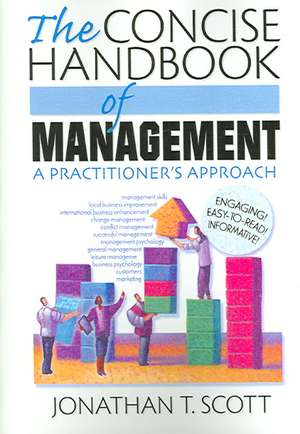The Concise Handbook of Management: A Practitioner's Approach
Autor Jonathan T. Scotten Limba Engleză Paperback – 20 sep 2005
Focusing on the pervading belief that everything a manager does must be customer oriented, The Concise Handbook of Management: A Practitioner’s Approach gives you an overview of everything you need to know about managing in one practical, concise book. This plain-talking guide not only explains management theories, but also presents commonsense suggestions on the best ways to effectively manage people and things, no matter what type of business you are in. Taking a practitioner’s approach of discussing management issues with customers ultimately in mind, this practical book motivates, is easily understandable, and is entertaining to boot.
The Concise Handbook of Management: A Practitioner’s Approach uses succinct chapters with several real stories and case studies designed to clearly illustrate each concept and suggestion. Written with the busy manager in mind, each chapter is compact, clear, true-to-life, and is always aimed at the bottom line. The book includes a small business marketing and promotion checklist, a helpful bibliography, and a useful glossary of terms.
The Concise Handbook of Management: A Practitioner’s Approach explores:
- the first three steps in becoming a good manager
- understanding the importance of customers
- getting the most from employees
- management competencies and styles
- organizational structures and cultures
- managing change
- managing conflict and stress
- managing teams and workgroups
- ethics
- leadership
- managing time
- written business communication
- mastering the skills of a presentation
- dealing with people in the workplace
- a small business marketing checklist
- project or program planning
- the marketing basics—product—strategy—marketing—pricing
- developing external and internal customers
| Toate formatele și edițiile | Preț | Express |
|---|---|---|
| Paperback (1) | 371.31 lei 6-8 săpt. | |
| Taylor & Francis – 20 sep 2005 | 371.31 lei 6-8 săpt. | |
| Hardback (1) | 768.12 lei 6-8 săpt. | |
| Taylor & Francis – 5 oct 2005 | 768.12 lei 6-8 săpt. |
Preț: 371.31 lei
Preț vechi: 544.69 lei
-32% Nou
Puncte Express: 557
Preț estimativ în valută:
71.05€ • 74.38$ • 58.79£
71.05€ • 74.38$ • 58.79£
Carte tipărită la comandă
Livrare economică 07-21 aprilie
Preluare comenzi: 021 569.72.76
Specificații
ISBN-13: 9780789026484
ISBN-10: 0789026481
Pagini: 278
Ilustrații: illustrations
Dimensiuni: 148 x 210 x 18 mm
Greutate: 0.51 kg
Ediția:1
Editura: Taylor & Francis
Colecția Routledge
Locul publicării:Oxford, United Kingdom
ISBN-10: 0789026481
Pagini: 278
Ilustrații: illustrations
Dimensiuni: 148 x 210 x 18 mm
Greutate: 0.51 kg
Ediția:1
Editura: Taylor & Francis
Colecția Routledge
Locul publicării:Oxford, United Kingdom
Cuprins
- Preface. Why Another Book About Management?
- Acknowledgments
- PART I: BUILDING THE MANAGEMENT FOUNDATION
- Chapter 1. What Is Management?
- Chapter 2. A Brief History of Management
- The Industrial Revolution and the Division of Labor
- The Study of Management Begins
- The Evolution of Scientific Management
- Perhaps the Most Important Study of All
- Chapter 3. The First Three Steps to Becoming a Good Manager
- Step 1: Mind-Set
- Step 2: Integrity
- Step 3: Training
- Chapter 4. Understanding the Importance of Customers
- Losing Touch
- Understanding External and Internal Customers
- The Ten Commandments of Business Success
- What Is Good Customer Service?
- The Final Word
- PART II: BASIC THOUGHTS ON AND THEORIES OF MANAGEMENT
- Chapter 5. Management Competencies and Styles
- Managerial Competencies
- Managerial Styles
- To Recap
- Chapter 6. Getting the Most from Employees
- Tapping into the Workforce
- Delegating Responsibility
- The Employee-Customer Connection
- Employee Empowerment
- Summary
- Chapter 7. Organizational Structures and Cultures
- Bureaucratic and Adaptive Organizations
- Organizational Cultures
- Can Structure and Culture Be Changed?
- Chapter 8. Managing Change
- Preparing for Organizational Change
- Understanding Resistance to Change
- Building the Commitment to Change
- Change Management: Some Examples
- Chapter 9. Managing Conflict
- The Value of Conflict
- The Nature of Work-Related Conflict
- Dealing with Conflict
- Battling the Stress That Work and Conflict Create
- Putting It All Together
- Chapter 10. Managing Teams and Work Groups
- Types of Teams
- Developing a Functional Team
- Overcoming the Obstacles of a Team
- Chapter 11. Managing by Objectives
- Goal Setting: A Three-Step Process
- Management by Objectives
- Chapter 12. Quality
- Achieving Quality
- Measuring Quality
- Putting Quality into Action
- Chapter 13. Ethics
- Ethical Behavior
- Four Levels of Organizational Ethics
- Unethical versus Ethical Decision Making
- Whistle-Blowing
- The Bottom Line
- Chapter 14. Leadership
- Leadership versus Management
- Leadership: Abilities and Action
- Coming to Grips with Leadership Theory
- The Nature of Leadership
- Chapter 15. Management: Theory versus Practice
- A Practical Example
- Theory versus Practice: A Metaphor
- Chapter 16. Managing in Different Cultures
- Culture and Human Behavior
- Errors in Cultural Perceptions
- Culture Shock
- Communicating in Different Cultures
- In Conclusion
- PART III: THE BASIC SKILLS OF MANAGEMENT
- Chapter 17. Managerial Decision Making and Problem Solving
- Making Up Your Mind
- Good Problem Solving and Decision Making: A Step-by-Step Approach
- Practices to Avoid When Making Decisions
- Chapter 18. Managing Time
- Understanding Effective Time Management
- Tips for Maximizing Your Time
- The End Game: Making Life Easier
- Chapter 19. Dealing with People in the Workplace
- Understanding Employee Behavior (Four Theories)
- Corrective Communication
- Behavior Modification
- Summing Up
- Chapter 20. Oral Communication in the Workplace
- Dealing with Difficulties As They Arise
- A Few Communication Basics
- A Final Tip
- Chapter 21. Written Business Communication
- The Roles of Busi
Descriere
Focusing on the pervading belief that everything a manager does must be customer oriented, The Concise Handbook of Management: A Practitioner's Approach gives you an overview of everything you need to know about managing in one practical, concise book. This plain-talking guide not only explains management theories, but also presents commonsense suggestions on the best ways to effectively manage people and things, no matter what type of business you are in. Taking a practitioner's approach of discussing management issues with customers ultimately in mind, this practical book motivates, is easily understandable, and is entertaining to boot.



















